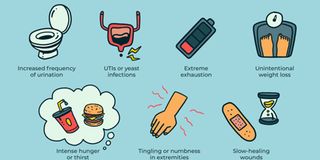Prime
Why you should not ignore early signs of diabetes

Warning signs of diabetes. Photo | Verywell Health
What you need to know:
- You can prevent or reverse prediabetes with proven lifestyle changes such as losing weight if you are overweight, eating a healthy diet, and getting regular physical activity. November being diabetes awareness month, we look at some of the early signs of the disease to enable you get early diagnosis.
Prof Marcel Andrew Otim, a diabetologist and endocrinologist at Nakasero Hospital in Kampala, is one of the oldest practising diabetologists in Uganda and Africa.
He started his practice in 1972 and at the time, the diabetes registry at Mulago National Referral Hospital had only 256 patients.
The number, according to Prof Otim, grew rapidly during President Idi Amin's era due to ignorance about what to eat.
“During that time, people who were fat were considered men of honour and respect. If one needed two beers, they had to buy a plate of food first. This facilitated more eating and drinking in order to gain weight. People who gained weight from such eating were referred to as mafuta mingi,” he says.
When the Asians were displaced, more businesses were left in the hands of Ugandans, which changed the nutrition profile of many Ugandans inevitably encouraging diabetes. By 1984, there were more than 1,800 patients in the diabetes registry at Mulago National Referral Hospital. In 2010, the number had increased to 11,000.
The diabetes registry at Kampala Diabetes Centre in Kamwokya, Kampala, currently has nearly 2,000 patients since its inception in 1999. Today, about five million people in Uganda are living with diabetes.
What is diabetes?
Diabetes is a chronic health condition that affects how the body converts food into energy.
According to the Centers for Disease Control and Prevention (CDC), there are three main types of diabetes; type 1, type 2, and gestational diabetes which affects some pregnant women. Type 1 diabetes can be diagnosed at any age and is thought to be caused by an autoimmune reaction. This type is only managed by a daily intake of insulin since it has no cure.

The most reliable way you can find out if you or a loved one has diabetes is from blood tests that measure your blood glucose (sugar) levels. PHOTO | FILE
Type 2 on the other hand comes with age and contributes up to 80 percent of global diabetes cases. For this type of diabetes, the body does not use insulin well and cannot keep blood sugar at normal levels. It may take weeks to years for one to develop symptoms of diabetes, depending on the type.
While symptoms of type 1 diabetes can appear in a few weeks or months, type 2 diabetes symptoms might take several years to develop.
Warning signs
Prof Otim says diabetes is a combination of hypertension, obesity, high blood sugar and elevation of cholesterol in the blood.
These are sometimes referred to as metabolic syndrome and all have a negative impact on our bodies. They account for blindness, stroke, heart disease and kidney damage. Diabetes is by far the leading cause of amputations globally followed by trauma, he adds.
You may know some of the most common first signs and symptoms of diabetes which include blurry vision, general body weakness, increased urination, wounds that take long to heal, numbness in your hands and feet and many others.
However, there are some uncommon symptoms of the disease that you may ignore but are important for you to know so that you get an early diagnosis. With early diagnosis, you can manage your diabetes easier which reduces the complications that come with the disease.
Gum disease
Gum disease (periodontitis), a disease in which gums pull away from the teeth, quickly progresses among people with diabetes according to Prof Otim. Diabetes is also associated with frequent infections since the disease lowers one’s immune system. The infections are usually hard to treat.
“High blood sugar levels create an environment for germs to grow and weaken the immune system. As a result, you may suffer from frequent bacterial or fungal infections that do not heal quickly,” Prof Otim says.
The commonest bacterial infections among people with diabetes affect hair follicles, nails, eyelids and the urinary tract causing folliculitis, paronychia, boils and styes. Fungal infections such as candida, athlete's foot, jock itch, ringworm, and vaginal yeast infections.
Blurry vision
Excess blood sugar levels damage the small vessels in the eyes causing blurry vision, and trouble reading and seeing objects far away. If not managed, one can develop glaucoma, floating spots or even complete blindness. Weight gain is one of the most common risk factors for diabetes. About 80 per cent of people with diabetes are obese. However, not all people with diabetes are overweight or obese. Sometimes, unexplained weight loss can be an early symptom of diabetes.
“When the body lacks enough insulin to move glucose into your cells, causing your body to burn fat instead. This in turn causes weight loss,” Prof Otim says. Some skin conditions such as Acanthosis nigricans are warning signs of diabetes.
The dark, velvety thick patch on the skin usually appears on the back of the neck, feet, groin, elbows and knees. Other skin conditions such as diabetic blisters, digital sclerosis, eruptive xanthomatosis, and necrobiosis lipoidica diabeticorum: here, blood vessel changes cause these large, deep, painful, and itchy sores. Diabetes that is poorly managed might damage nerves causing diabetic neuropathy (causing tingling and numbness).
“Diabetes can affect how nerves send and receive messages. Peripheral neuropathy, for instance, causes tingling and numbness in the arms, hands, feet, fingers, or legs,” he says. When diabetes affects a pregnant woman, she is likely to suffer from abortion, stillbirth, give birth to overweight babies and other pregnancy-related complications.
Management
Pregnant women and people with a high risk of diabetes need regular tests even if they do not have symptoms. Prof Otim advises one to seek medical advice about testing for diabetes if you have symptoms such as feeling confused, chest pain, shortness of breath, frequent urination and feeling thirsty all the time.
According to the CDC, gestational diabetes usually goes away after you give birth, but increases your risk of suffering from type 2 diabetes. Your baby is more likely to have obesity as a child or teen, and to develop type 2 diabetes later in life.
“Before you get pregnant, you may be able to prevent gestational diabetes with lifestyle changes. These include losing weight if you are overweight, eating a healthy diet, and getting regular physical activity,” the CDC states.
“The good thing,” Dr Otim says, “most people with type 2 diabetes do not need insulin. In fact, routine use of insulin is not recommended. There is a need for proper nutrition, education of patients and the community, exercise, oral medication and self-monitoring.”
He adds, “We can claim that if handled properly, type 2 diabetes can be prevented and reversed.”
FOODS TO PREVENT DIABETES
Choosing the right foods will help decrease the chances of developing Type 2 diabetes. It is important to start eating a well-rounded diet before diabetes sets in.
Cruciferous vegetables
Leafy, dark green vegetables contain fibre, antioxidants, minerals, vitamins A, C and K, and potassium. Brussels sprouts, cabbage, kale, spinach and cauliflower are good vegetables to incorporate into your diet.
Protein
Try lean meats such as skinless chicken breasts, lean turkey, salmon, beef sirloin, pork loin, cod, tilapia, halibut, shrimp, crab, lobster and mussels.
Fruits
Eat fruits high in antioxidants and vitamins such as blueberries, blackberries, apples and oranges.
Whole grains
Swap out processed snacks such as chips and white crackers for whole grain crackers and popcorn. Skip the white bread and bagels in favour of whole-grain options. And try brown rice and quinoa for a healthier alternative to white rice and pasta.
Source: www.osfhealthcare. org




